Non-topics
First Bilingual Museum of Sex Exhibition Highlights LGBTQ Life in Peru
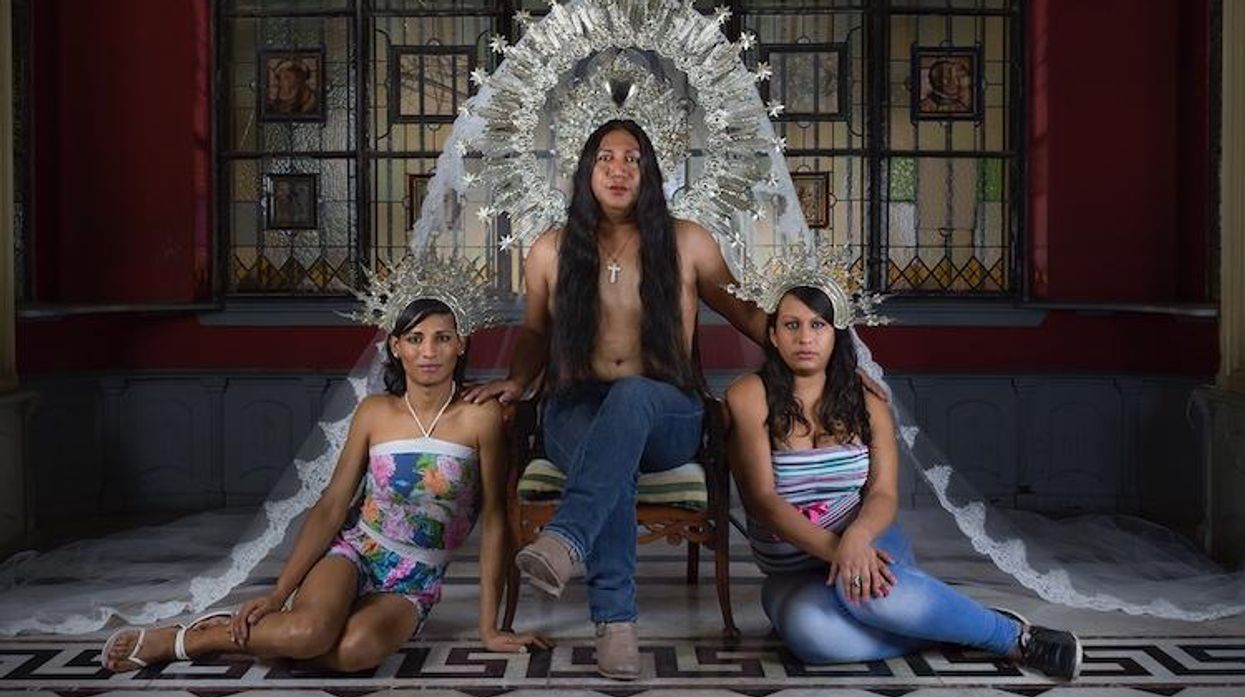
Talking with the artists & curator behind Canon: Photographs by Juan Jose Barboza-Gubo & Andrew Mroczek.
October 20 2017 1:53 PM EST
By continuing to use our site, you agree to our Privacy Policy and Terms of Use.

Talking with the artists & curator behind Canon: Photographs by Juan Jose Barboza-Gubo & Andrew Mroczek.
The Museum of Sex (MoSex) offers visitors everything one may expect from their scintillating yet simplistic moniker. Yet, the Flatiron District staple since 2002 isn’t merely a bastion of hedonism and lurid pleasure. In fact, MoSex’s mission is to “preserve and present the history, evolution and cultural significance of human sexuality.” In line with this, they are presenting their first ever bilingual exhibit Canon: Photographs by Juan Jose Barboza-Gubo & Andrew Mroczek, which is on display from October 20 to January 15, 2018. We sat down with artists Barboza-Gubo and Mroczek, and curator Lissa Rivera to further discuss this groundbreaking, immersive exhibit.
OUT: How did you discover the photographs of Juan Jose Barboza-Gubo and Andrew Mroczek?
Lissa Rivera: I've been following Andrew's work for a long time. When I moved to New York City we fell out of touch for a while. I got back in touch, and I saw this new collaboration with Juan. I was completely amazed by the depth and ambition of their exploration. They showed me one incredible image after another that was just completely breathtaking. Their images have political immediacy, and—at the same time—they stay with you and feel like a larger part of history. That's what really drew me to their work.
What made you decide to develop and then curate Canon for the Museum of Sex?
Lissa: I feel that this work documents and empowers a community that is being oppressed for their sexuality and gender expression, and the Museum of Sex is a place where we strive to promote a greater understanding and acceptance of all kinds of expression. I think Canon is especially unique because it addresses both Spanish and English-speaking people, and Spanish-speaking New Yorkers are a valued part of our audience. I really wanted to exhibit work that speaks directly to them without translation, and I want our visitors who are exploring their gender or sexual identities to feel like they are in a place, at least in this building, where they are safe to talk about these complex subjects. And, I want to challenge people to see that these problems are not only Peru's, but a global responsibility.
What was the inspiration for you photo series Virgenes de la Puerta (Virgins of the Door), Los Chicos (The Boys), Padre Patria (Fatherland), and the video performance piece Anda?
Juan Jose Barboza-Gubo: When I was about 8 years old, I was in one of the streets in Lima—really close to my house—and I saw somebody really affecting a trans woman's life just because he was homophobic. So, I think that was pretty hard for me, as a kid. That is something that, through the years, I started thinking about and I started researching. Obviously, because of my sexuality, I started to try to understand why people had to behave that way, and the way that he behaved. Especially, in my country. That is a country that is not liberal at all. Also, religion is pretty heavy there, so they [the church] control a lot the way that people think. Basically, long story short, that is what originated the Virgens de la Puerta series.
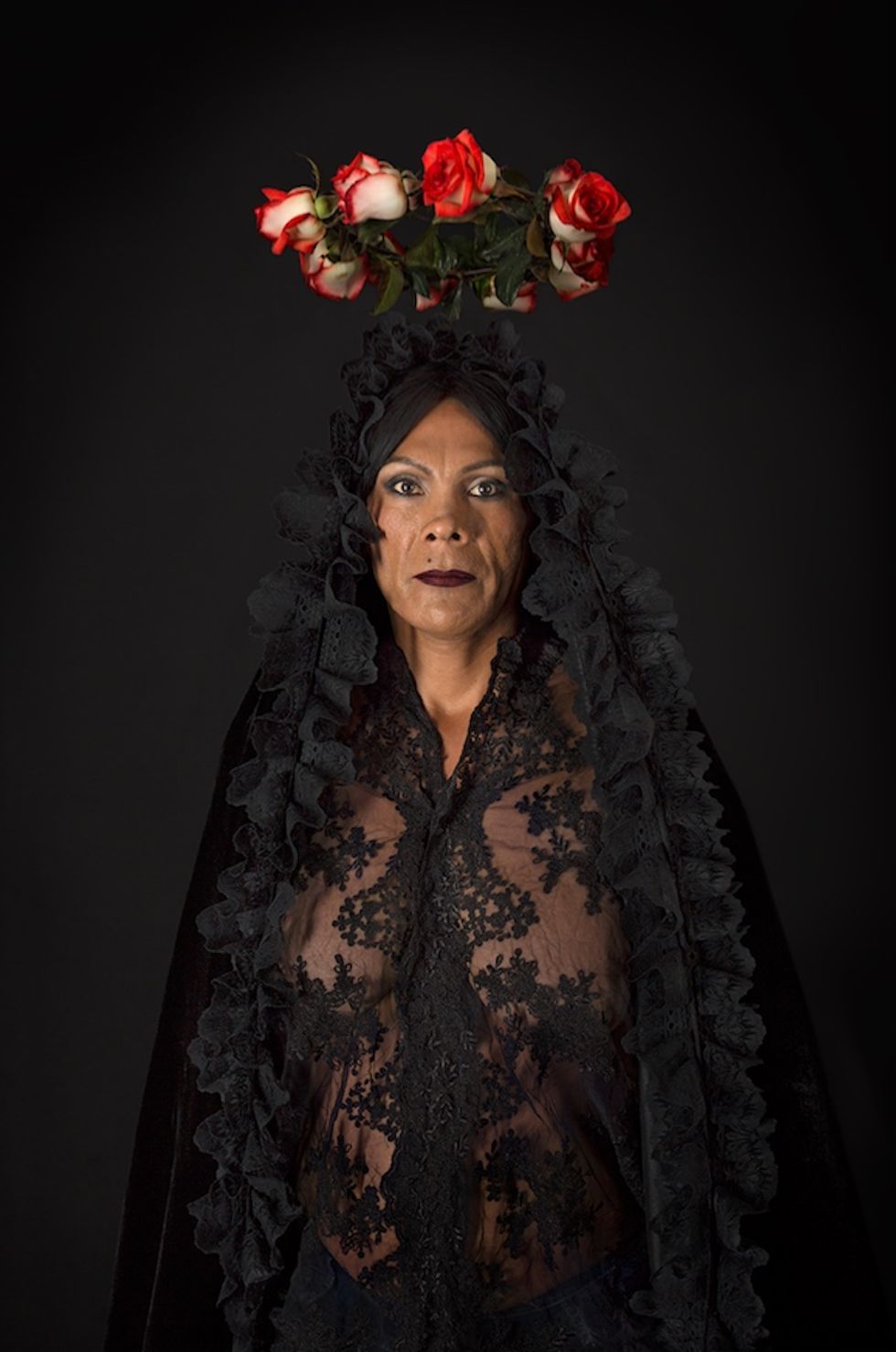
Virgenes de la Puerta (Photo Courtesy Museum of Sex)
Andrew Mroczek: I think Juan and I had worked together for almost 10 years as sort of artist and curator as I had curated several exhibitions that included Juan's work. In 2013, I was invited to curate a show at a gallery in Lima of his work, as well. At that time, Juan showed me what the culture was like in a more in-depth way. I got to meet a lot of the gay and trans community and really learn about how much that one act of violence that he saw when he was younger really impacted his work and his own development of his own identity. That experience in 2013 was life-changing for me in the sense that I realized just how strong corruption within the church, and corruption within politics, can really make violence, homophobia, and transphobia permissible things. And, that was beyond disturbing.
It was then that Juan and I decided we can do something about this. There was a lot of back and forth in terms of the role that we should play, or could play, or what was appropriate or not appropriate. But, what we did know, at least for the Virgens series, this was a community that no one was paying attention to. It was a community primarily of the trans women that we worked with that were considered the lowest form of life. There were no role models. There were no trans role models for younger trans girls. There were no opportunities for education, for employment. And, even trying to find ways to enter into that community from a good place, from a place of love and of trying to find ways to work together, was difficult because of how apprehensive many of them were.
That was the start of the project. From there, we realized that one of the most important parts of that project was finding a way to make these women feel as though they are a part of their culture. If there's anything anyone knows about Peru it is that Peruvians are so proud to be Peruvian. It's insane. [Laughs] So, when a Peruvian is not allowed to embrace their culture, it is a stigma that cuts really deep.
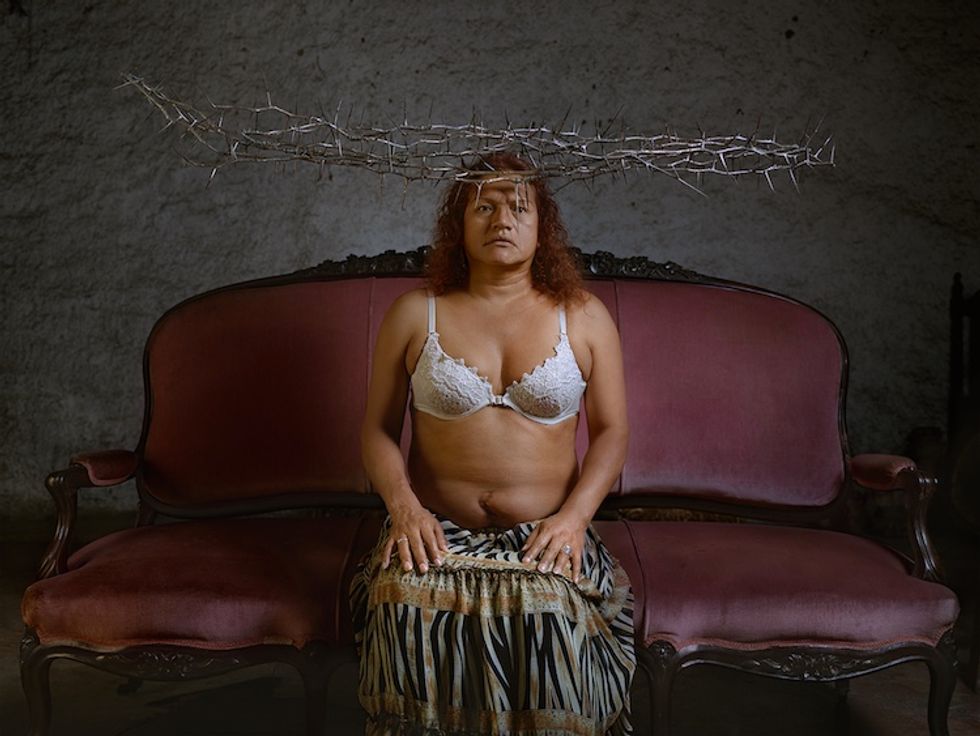
Virgenes de la Puerta (Photo Courtesy Museum of Sex)
Once we started working with these women, speaking with these women, going to the small community centers that they had developed or were beginning to develop, we learned about how in 2014 the subject of civil unions was part of the political discussion there. That was really forefronted by the younger generation of gay boys, essentially. You have to remember that Peruvian culture is very much about machismo, so the men are constantly pushed to the forefront, but gay men are always pushed aside. Here they were creating a platform for themselves. And that is sort of where the Chicos work began to sort of seed.
In working with both of those communities, we started hearing stories about violence and murder, and people who were being pushed aside, forgotten, crimes that were not being investigated, crimes that were not being reported because of safety issues, and we began to see that the community was divided between those who were allowing themselves to be visible and those who were being erased. How could we find a way to communicate to the larger Peruvian audience that their country, their backyard, the places that they vacation at are essentially scenes of a crime that they refuse to witness or refuse to acknowledge? That's where the Padre Patria series was really born.
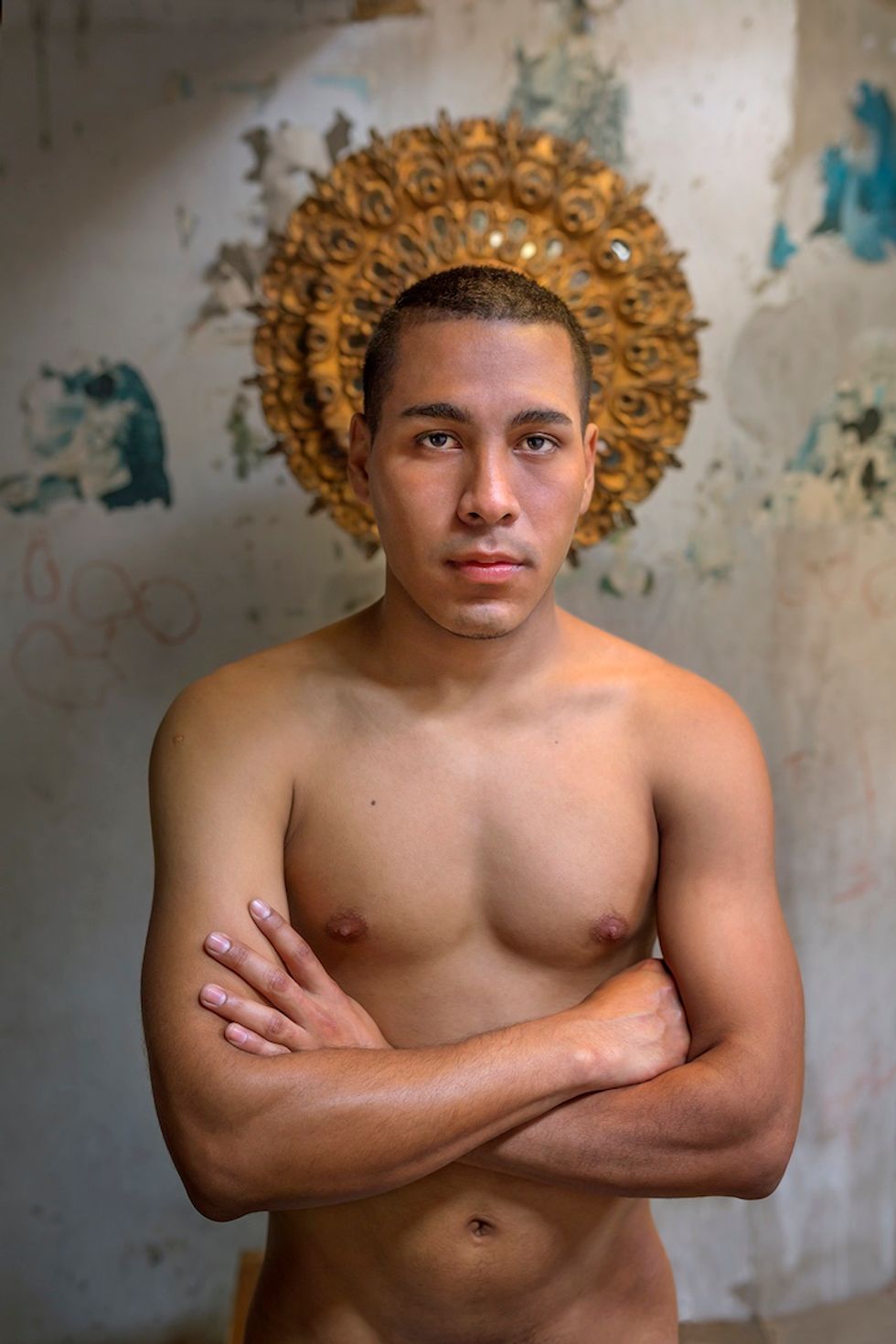
Padre Patria (Photo Courtesy Museum of Sex)
Is there anything you would like to add about the video piece Anda?
Andrew: I don't want to use the word "literal," but the work we had been doing up until that point was in some ways documentary and in some ways extremely literal. We were using very specific references, very specific visual language, and I think for both Juan and me, there is this moment where we had to step back and think how can we tell the same story, or a fragment of a story, in a different way that might appeal or speak to a different audience. That's sort of where the foundation for the Anda film was formed.
We had seen several processions, and there was this really magical procession that happened in downtown Lima. As the procession was carrying this anda to the streets there was a band playing, and it was everything you imagine these processions to be. Juan and I were filming, we looked up at the roofs, and there was a group of trans women that were following the procession on the roofs of the buildings. They were throwing flowers on to the effigy of the virgen being held on the anda, and at this moment there was a clear separation of people who were allowed to be part of the procession and the people who feel they need to be a part of this yet are not allowed to be there with it that somehow have to remain as outsiders or “the other.”
We thought about the way that religion, both visibly and invisibly, oppresses. Well, let me just say the church, not religion. The church visibly or invisibly begins to oppress people and the men who are part of the Anda series are men who want to be practicing Catholics, want to have a role in that religion, and they're rejected or not allowed to practice openly. And, yet, even though religion is slowly being removed from them, or the attempt is being made to remove religion from them, they're still burdened by the confines of what that really means. That is what the representation of the Anda film is for us.
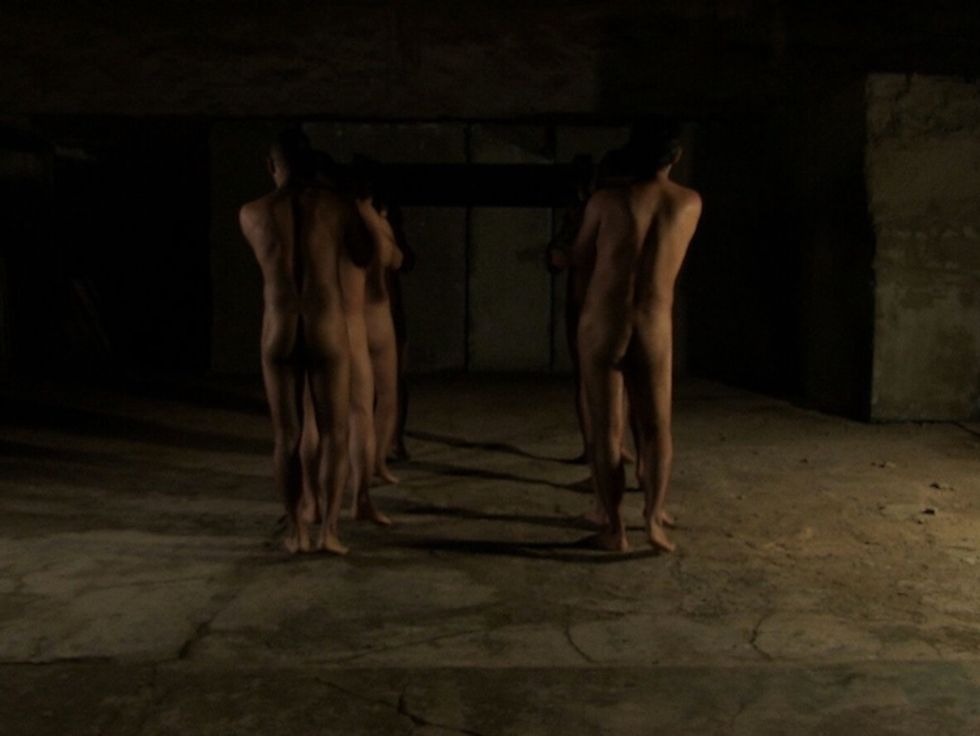
Video Still from Anda
In your opinions, what are the primary differences in the way that the LGBTQ communities in Peru and the United States are treated, and what bridges does Canon offer to create empathy and understanding.
Juan: Well, something that we need clarify here is basically, for the whole world and not just Peru, we have tried to elevate the image of these trans women. We researched a lot the contemporary art world, especially photography in contemporary art, and we tried really hard not to fall into representing these women in the ways that other people did. That was pretty hard to see. At least for me, they [trans women] could be used, they can be objectified, and actually they were. Most of the artists that I saw before were using them more as objects and as these really weird characters that would be sexy to photograph and make look weird.
I think it's really important to be careful with the power that art has, especially the mediums of photography or film because they come from reality. A painting is not a big deal because you know that the artist is manipulating a lot of information on the canvas and has the power to change things. In photography, that doesn't happen. I don't think they were helping the community, and I don't think they were helping these women because they were making them look weird.
Andrew: They were essentially fetishizing and sexualizing them.
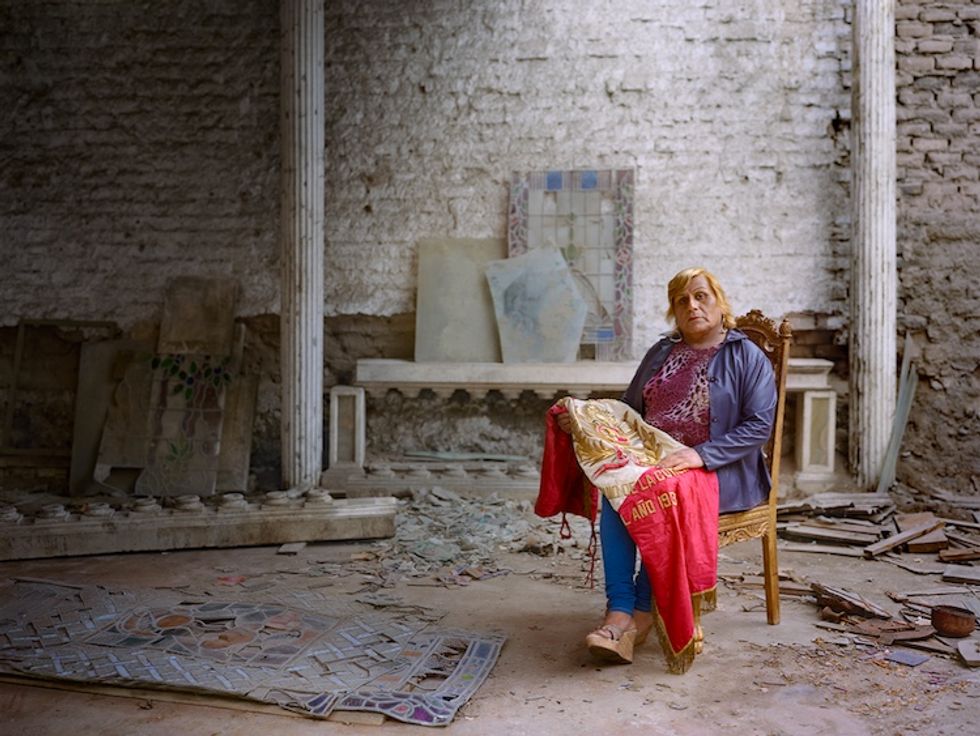
Virgenes de la Puerta (Photo Courtesy Museum of Sex)
Juan: Exactly. That was something that we were conscious about and that we didn't want to do. We wanted them to be accepted. We want people to understand who they are, understand their bodies. That's another reason why you will see some of the photos are covered, some of the photos are semi-naked, aid in one of the photographs you will see a fully nude figure. So, people need to understand that it is not this weird thing that they imagined. It's just one more body. And, it is the same with the images. We tried to make them look as beautiful as we could.
Andrew: Talking about some of the differences in the ways that the communities are treated in the U.S. versus Peru, I do want to mention that as an American, when I travel to another country—in South America specifically, in Peru, working on a project of this type—sometimes the first thing that I see is what's missing. That's because I'm used to being surrounded by words, terminology, and organizations that have been created whether by mass media or by smaller groups. I think about GLAAD; I think about the HRC; I think about allies. And, when you go to Peru, the biggest difference that I saw was there really are no advocates and allies the way there are here in the U.S. We do have the luxury, and I use that term loosely, to portray trans and gay people differently or the way that we want to artistically in the U.S., whether it's positive or negative. In Peru, it's rarely, if ever, positive. That was disturbing, and then again, that was another moment when you realize this is what's missing.
I think that harks back to what you were getting to as well, Juan, making sure that these people come across as strictly human and not as some sideshow oddity to be gawked at. I’ve read this exhibit is imxmersive. How is it immersive, and what is that going to do to enhance that experience for viewers?
Andrew: I work in exhibitions myself at a university here in Cambridge, Massachusetts, but working from the artist or being the exhibiting artist for another institution is always really interesting in the way that your work is viewed and/or perceived by a different group. Working with Lissa and the staff at Museum of Sex has been phenomenal in the aspect that they were most interested in finding a way to communicate this work and present it in a way that was very immersive, that goes beyond the idea of these are images from reflecting a different culture. They're really interested in the way that the texture of the walls, the colors that they are using, the lighting, the materials, the textiles that will be in the exhibition will help support the work and provide an experience for the viewers that goes beyond the separation between the viewer and the image. It's really about the way that the space will allow the viewer to enter into a very specific culture.
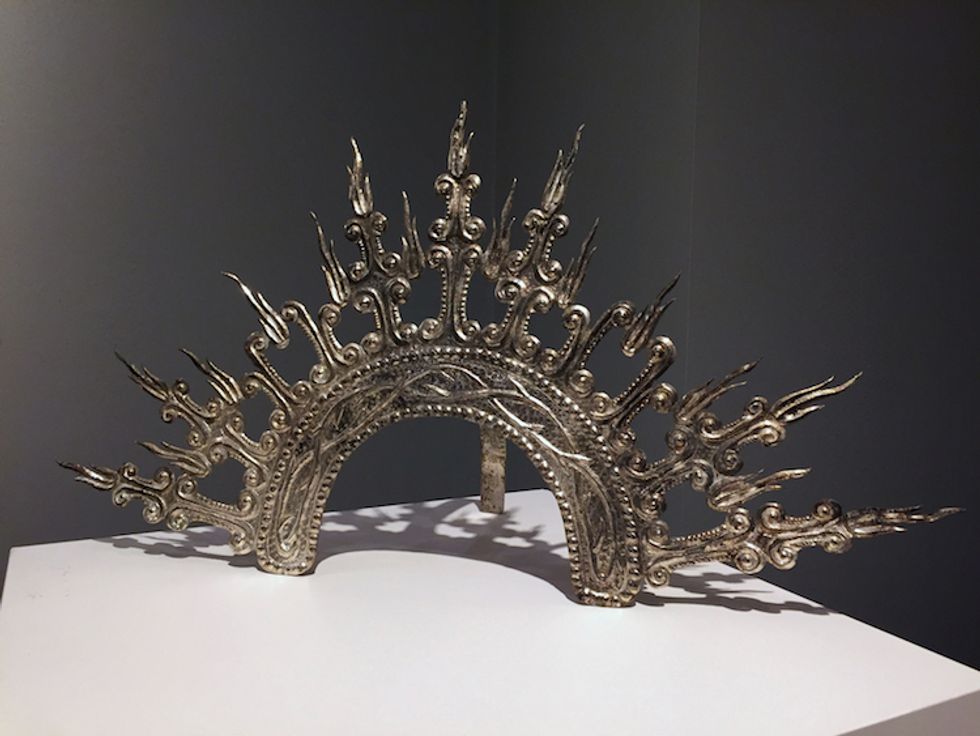
Photo Courtesy Museum of Sex
Lissa: There is so much texture and so much detail to take in in the photographs. And, I just couldn't help but want to kind of be inside of them. I want the viewers to feel like they're inside of them so they connect with these subjects that have a lot to share. Like Andrew said, we're putting plaster on the wall that will reference the colonial architecture of the mansions in which the photos were staged.
Also, the original costumes that Juan and Andrew commissioned will be on display. They have created bejeweled gold and silver crowns that are like the types of crowns that would be made for statues of icons within the church. They also have this incredible beaded and lace encrusted cape that is just going to be stunning, and it's also worn in one of the photos. I just want people to see that they're not just props, they're works of art in their own right. That's a very unique thing that goes beyond what many photo projects have to offer.
I think that seeing them worn by the “virgens” and “los chicos” in images, and then in person in the gallery would give the sense of the visceral realities and the spiritual weight behind the photographs. This way there is a heaviness and a seriousness to this issue, but there is also a beauty. I want people to feel that.
I'm also looking to create an olfactory experience with the scent of Palo Santo, which is the incense that is burned in churches and also used to cleanse spaces. I like the idea of cleansing a space and reclaiming a space. And, the videos we'll be playing also have a drone, and the drone really connects you in a way, helps you to focus, and leave the world that you were in before you walked into the gallery in another place. All of these things just came easily to my mind. They were things that I felt just by looking at the photos alone, without any staging.
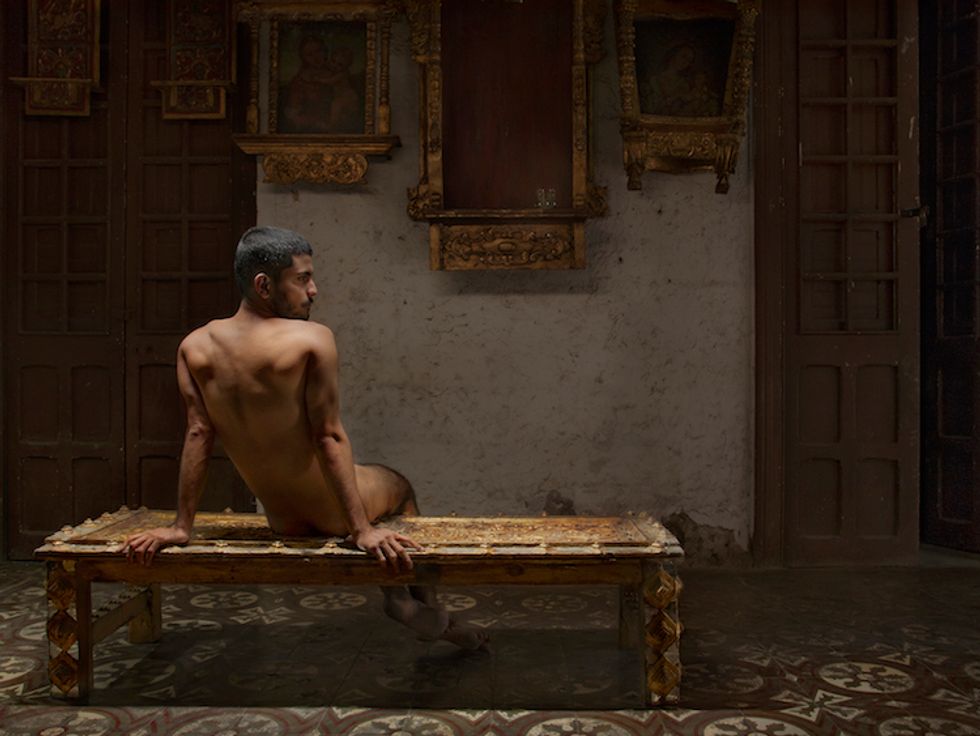
Padre Patria (Photo Courtesy Museum of Sex)
The exhibitions and the pieces themselves are exploring the intersectionality of race, culture, and sexuality. Tell me more about these components and how they are important to you?
Andrew: It's important for everyone who is a part of any community to be an active member of that community. That can take form and shape in many different ways.
When Juan and I first started this project, there was this moment where we had to decide what was appropriate, what wasn't appropriate, the way we approached the subject itself, and the way that we approached working with these people. For us, it was important to let them tell their stories, whereas we are not the storytellers. We are simply presenting, or creating a platform for the women, specifically, to fight for their own equality. I don't think any of the women were interested in working with us so that we can be their voice. They were interested in being a part of this project because they wanted a new platform, a different platform, that can be heard.
That's why we see this project as being successful already because we see the ways in which the women have utilized this body of work to promote unity and equality within their community. They’re finding ways to support their community through AIDS awareness, helping sex workers get off the street, and finding ways to come together. They've really used the publicity that this work has had so far as a means to prove to other Peruvians that this is legitimate, that their lives are legitimate, and that has become incredibly important for me, and I am sure for Juan as well.
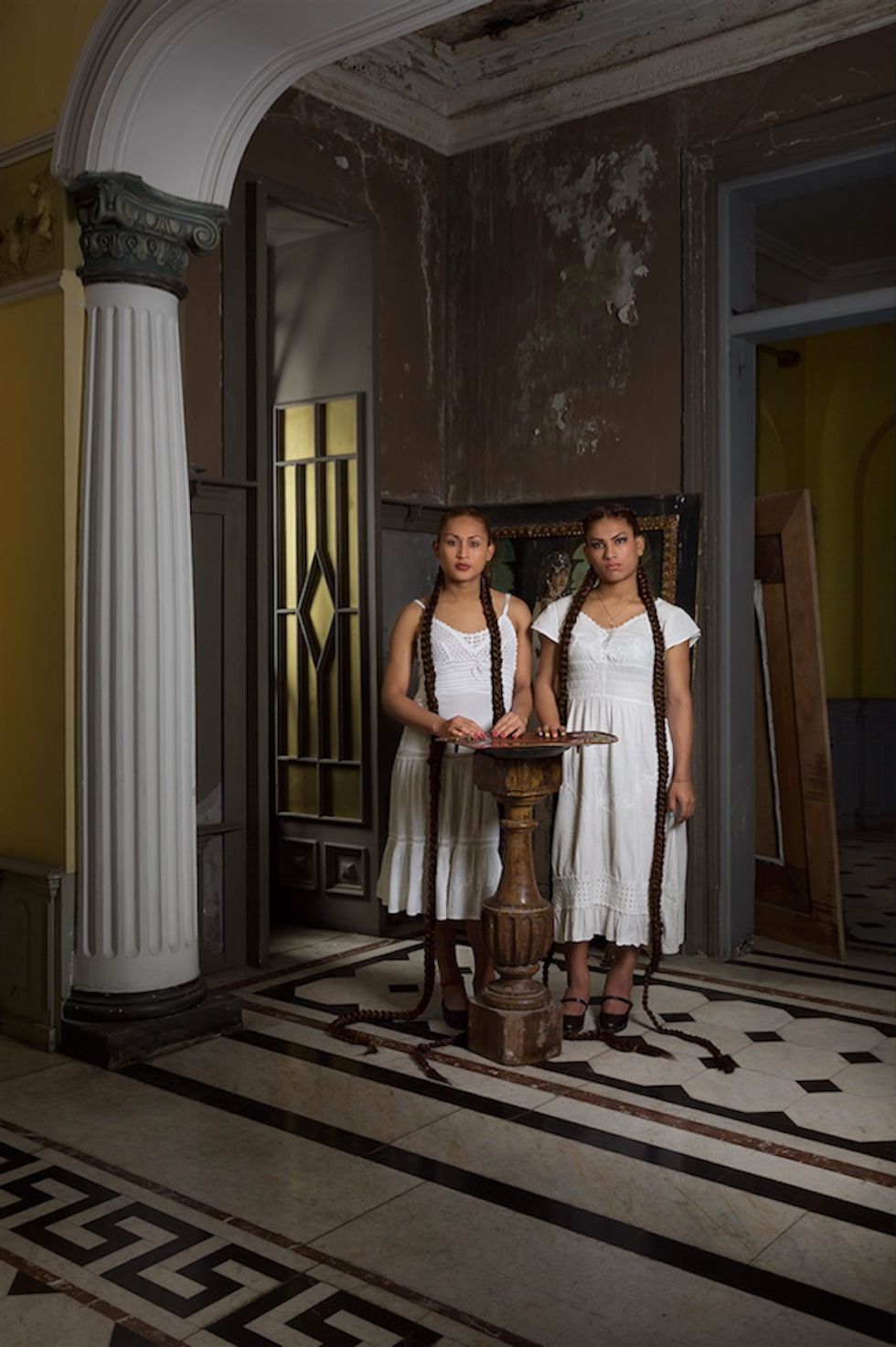
Virgenes de la Puerta (Photo Courtesy Museum of Sex)
Lissa: I was thinking that even though these images are specifically about Peru, there's a human element to the story that is universal. The photos explore how gender and sexuality actually can't be disentangled from broader culture and the history of a place or the legacies of colonialism, race, religious and cultural beliefs, and practices. The same thing is true in the Unites States. We're grappling with the ongoing legacies of colonialism, and the culture wars here are still ongoing. Juan and Andrew's photos embrace religious iconography, expressing the genuine faith in many of their subjects. But, then, they reclaim it from those which used religion as a tool to exclude or oppress.
I just want to remind people that it was not very long ago that LGBTQ people in our country were left to die by the thousands, denied basic information about sexual health, and that many people in these photographs are fighting for their rights, their health, and their lives. Juan and Andrew's photographs demand that we accept transgender and queer people as part of culture and history.
Related | Power to the People: Exploring Marsha P. Johnson's Queer Liberation
Andrew: I do want to mention that the idea of whose role it is to tell stories has been at the forefront of the media right now, especially with the film on Marsha P. Johnson. One of the ways I felt that, as an American-born artist, I can do something with this community was because I had to remind myself that the LGBTQ community is a community without borders. Politically, we cannot separate ourselves. We cannot separate ourselves by geography. Every little victory we have, big or small, it's really for the greater good. I find it hard to believe that the work that we are doing in Peru isn't affecting or impacting LGBTQ people in other countries and other cultures. I hope that it will empower them the way that is has empowered us.
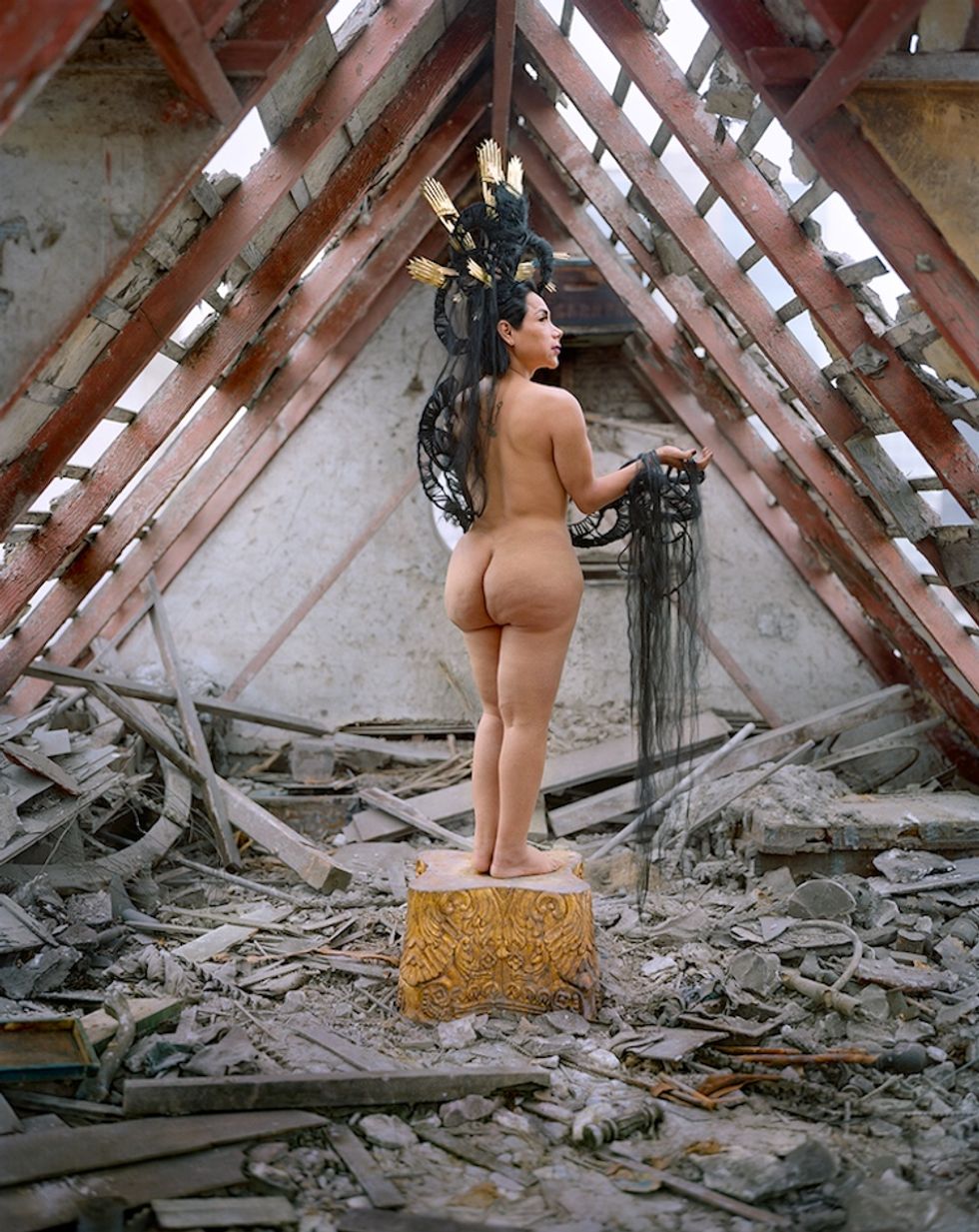
Virgenes de la Puerta (Photo Courtesy Museum of Sex)
This is the first bilingual exhibition to ever be shown at the Museum of Sex. Considering the current zeitgeist of xenophobia that is currently spreading across the globe, what is it like being part of such a groundbreaking moment for the MoSex?
Lissa: I felt like it just seemed obvious to have an exhibit where Spanish-speaking people could read without translation because it's New York City and it's the United States. Spanish-speakers are the people I work with, these are my neighbors, and I want them to feel comfortable in the museum. Yes, we are witnessing a frightening increase of xenophobia and nationalism in the U.S. right now, but, at the Museum of Sex, I want to create a bridge between cultures. That is really important to me.
Juan: I have the text of the curator of the Museum of Contemporary Art in Lima that is making text for this exhibition in front of me right now, and I was reading the last paragraph. He's mentioning something that I think is going to be important. I want to try to translate it. He mentions the changes that could exist in Peru thanks to this work and thanks to last year’s gay pride increasing in size and the quantity of people that are attending. He also makes a comparison with the United States and how things, at some point, were moments of change that helped the community become accepted and how we gained access certain rights.
But, he ends up saying that there are big concerns based on the current President of the United States. There is a danger of losing everything that we've gotten up to this point and even losing lives of people in the community. I think it's an interesting comparison because that is what the people of Peru are seeing. In Peru, they see international news, but the people of South America are really focused on what happens in the United States and not as much what happens in Europe. It is just interesting that he just ends the text saying that his view as a Peruvian, as an artist, as a curator, and as an art historian is that he is really concerned about what is going to happen in this country if we still have, in a few years, this person in power.
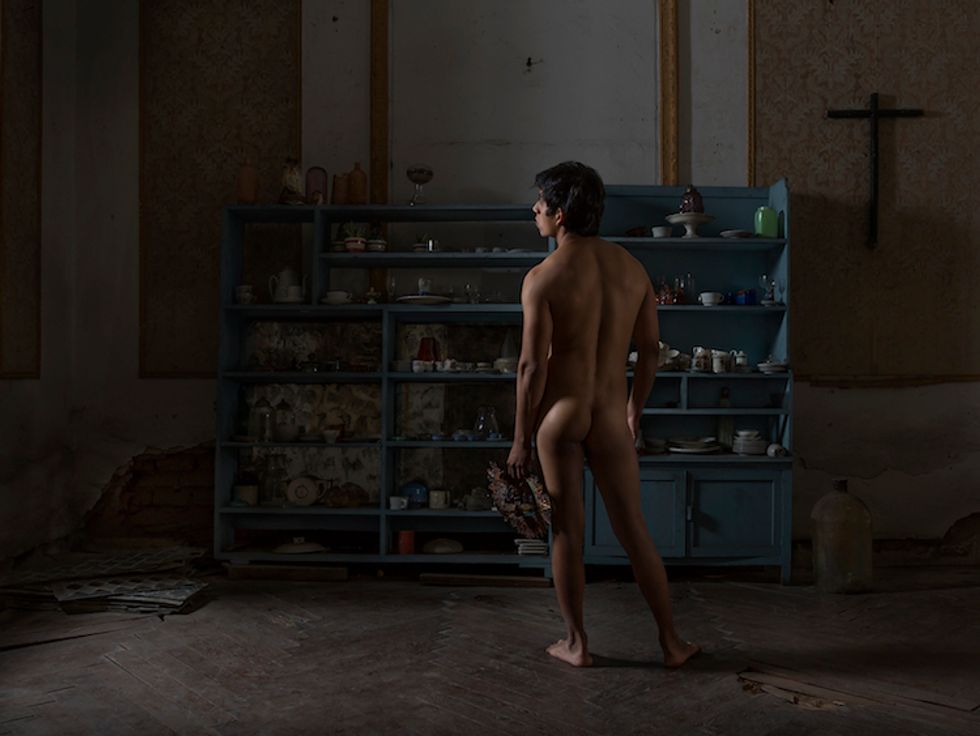
Padre Patria (Photo Courtesy Museum of Sex)
Andrew: What I love most about having this work at the Museum of Sex—not just for all the reasons that Lissa mentioned before—is the fact that it's 5 or 10 minutes away from the Stonewall Inn. I think about that distance and how close the images of these men and women will be from such an iconic landmark for the LGBTQ movement here and how, in many ways, in Peru, they're so far from it. And, although it's getting better, there is a distance. There is a really feasible distance. You can feel it—it's almost tactile sometimes—the oppression that these people experience there. So, to have it here, in the U.S., in New York, and with all of the bodies of work complete as this is the first time that they'll be shown together on one floor in one building that is so close to such an important place in LGBTQ history is truly a gift. I really do thank Lissa, the staff, and all of the crew of the Museum of Sex for allowing us that opportunity and for giving the men and women of Peru that voice.
Lissa: I think that New York City, too, has been a place where people go when they are facing oppression for their sexuality, for their gender, for all different reasons. I think people come here to find other people like them—people who have different ideas who might not fully be able to express themselves. Whether they're coming from a rural area in the United States or whether they're coming from another country where it's quite dangerous to be openly queer which is unlike NYC This city is a place where there has been gay bars for a long time, there has been places where people could gather. So, the Museum of Sex is a place where people come to in New York, and it symbolizes that history. People want to come here. There's a disco here. It's a place where things aren't censored, and there's open conversation. I just thought, “Why isn't this work all over the place? Why isn't it being seen? Are people afraid? I'm not afraid. This is the place.” So, as soon as I had the opportunity, I was excited to show this work.